Antioxidant Interactions between Citrus Fruit Carotenoids and Ascorbic Acid in New Models of Animal Cell Membranes
Abstract
:1. Introduction
2. Materials and Methods
2.1. Chemicals
2.2. Plant Material and Storage Conditions
2.3. Carotenoid Extracts
2.4. Carotenoid Quantification
2.5. Carotenoid and Ascorbic Acid Stock Solutions
2.6. Experimental Design
2.7. Determination of Singlet Oxygen Absorption Capacity (SOAC)
2.8. Determination of Micellar Singlet Oxygen Absorption Capacity (SOACmic)
2.9. Fitting Curves
2.10. Liposomal Systems
2.11. Preliminary Oxidation Assays
2.12. Liposome Oxidation
2.13. Thiobarbituric Acid-Reactive Substances (TBARS)
2.14. Statistical Analysis
3. Results
3.1. Characterization of Carotenoid Extracts
3.2. Preliminary Oxidation Assays
3.3. Preliminary Assays with Ascorbic Acid
3.4. Antioxidant Properties of Citrus Carotenoids with/without Ascorbic Acid
4. Discussion
4.1. Carotenoid Content in Citrus Fruits
4.2. Oxidizable Properties of AML
4.3. Antioxidant Interactions between ASC and Citrus Carotenoids
5. Conclusions
Supplementary Materials
Author Contributions
Funding
Institutional Review Board Statement
Informed Consent Statement
Data Availability Statement
Acknowledgments
Conflicts of Interest
Abbreviations
References
- Grabowska, M.; Wawrzyniak, D.; Rolle, K.; Chomczyński, P.; Oziewicz, S.; Jurga, S.; Barciszewski, J. Let food be your medicine: Nutraceutical properties of lycopene. Food Funct. 2019, 10, 3090–3102. [Google Scholar] [CrossRef] [PubMed]
- Pennant, M.; Steur, M.; Moore, C.; Butterworth, A.; Johnson, L. Comparative validity of vitamin C and carotenoids as indicators of fruit and vegetable intake: A systematic review and meta-analysis of randomised controlled trials. Br. J. Nutr. 2015, 114, 1331–1340. [Google Scholar] [CrossRef] [PubMed]
- Liu, Y.; Heying, E.; Tanumihardjo, S.A. History, global distribution, and nutritional importance of citrus fruits. Compreh. Rev. Food Sci. Food Saf. 2012, 11, 530–545. [Google Scholar] [CrossRef]
- Zacarías-García, J.; Rey, F.; Gil, J.V.; Rodrigo, M.J.; Zacarías, L. Antioxidant capacity in fruit of Citrus cultivars with marked differences in pulp coloration: Contribution of carotenoids and vitamin C. Food Sci. Technol. Int. 2021, 27, 210–222. [Google Scholar] [CrossRef]
- Rodrigo, M.J.; Alquézar, B.; Alós, E.; Medina, V.; Carmona, L.; Bruno, M.; Al-Babili, S.; Zacarías, L. A novel carotenoid cleavage activity involved in the biosynthesis of Citrus fruit-specific apocarotenoid pigments. J. Exp. Bot. 2013, 64, 4461–4478. [Google Scholar] [CrossRef] [PubMed]
- Lado, J.; Zacarías, L.; Gurrea, A.; Page, A.; Stead, A.; Rodrigo, M.J. Exploring the diversity in Citrus fruit colouration to decipher the relationship between plastid ultrastructure and carotenoid composition. Planta 2015, 242, 645–661. [Google Scholar] [CrossRef] [PubMed]
- Kato, M.; Ikoma, Y.; Matsumoto, H.; Sugiura, M.; Hyodo, H.; Yano, M. Accumulation of carotenoids and expression of carotenoid biosynthetic genes during maturation in citrus fruit. Plant Physiol. 2004, 134, 824–837. [Google Scholar] [CrossRef]
- Rodrigo, M.J.; Marcos, J.F.; Zacarías, L. Biochemical and molecular analysis of carotenoid biosynthesis in flavedo of orange (Citrus sinensis L.) during fruit development and maturation. J. Agric. Food Chem. 2004, 52, 6724–6731. [Google Scholar] [CrossRef]
- Grosso, G.; Galvano, F.; Mistretta, A.; Marventano, S.; Nolfo, F.; Calabrese, G.; Buscemi, S.; Drago, F.; Veronesi, U.; Scuderi, A. Red orange: Experimental models and epidemiological evidence of its benefits on human health. Oxid. Med. Cell. Longev. 2013, 2013, 157240. [Google Scholar] [CrossRef]
- Jahns, L.; Conrad, Z.; Johnson, L.K.; Whigham, L.D.; Wu, D.; Claycombe-Larson, K.J. A diet high in carotenoid-rich vegetables and fruits favorably impacts inflammation status by increasing plasma concentrations of IFN-α2 and decreasing MIP-1β and TNF-α in healthy individuals during a controlled feeding trial. Nutr. Res. 2018, 52, 98–104. [Google Scholar] [CrossRef]
- Duthie, S.J.; Duthie, G.G.; Russell, W.R.; Kyle, J.A.M.; Macdiarmid, J.I.; Rungapamestry, V.; Stephen, S.; Megias-Baeza, C.; Kaniewska, J.J.; Shaw, L.; et al. Effect of increasing fruit and vegetable intake by dietary intervention on nutritional biomarkers and attitudes to dietary change: A randomised trial. Eur. J. Nutr. 2018, 57, 1855–1872. [Google Scholar] [CrossRef] [PubMed]
- Widomska, J.; Zareba, M.; Subczynski, W.K. Can Xanthophyll-Membrane Interactions Explain Their Selective Presence in the Retina and Brain? Foods 2016, 5, 7. [Google Scholar] [CrossRef] [PubMed]
- Grudzinski, W.; Nierzwicki, L.; Welc, R.; Reszczynska, E.; Luchowski, R.; Czub, J.; Gruszecki, W.I. Localization and Orientation of Xanthophylls in a Lipid Bilayer. Sci. Rep. 2017, 7, 9619. [Google Scholar] [CrossRef]
- Sandmann, G. Antioxidant Protection from UV- and Light-Stress Related to Carotenoid Structures. Antioxidants 2019, 8, 219. [Google Scholar] [CrossRef] [PubMed]
- de Oliveira, B.F.; Veloso, C.A.; Nogueira-Machado, J.A.; Martins Chaves, M. High doses of in vitro beta-carotene, alpha-tocopherol and ascorbic acid induce oxidative stress and secretion of IL-6 in peripheral blood mononuclear cells from healthy donors. Curr. Aging Sci. 2012, 5, 148–156. [Google Scholar] [CrossRef] [PubMed]
- Jomova, K.; Valko, M. Health protective effects of carotenoids and their interactions with other biological antioxidants. Eur. J. Med. Chem. 2013, 70, 102–110. [Google Scholar] [CrossRef]
- Nadori, E. ‘Nadorcott’ Mandarin: A promising new variety. Proc. Int. Soc. Citricult. 2004, 1, 353–359. [Google Scholar]
- Barry, G.H.; Caruso, M.; Gmitter, F.G. Commercial scion varieties. In The Genus Citrus; Talon, M., Caruso, M., Gmitter, F.G., Eds.; Woodhead Publishing: Cambridge, UK, 2020; pp. 495–508. [Google Scholar]
- Zacarías-García, J.; Rambla, J.L.; Granell, A.; Rodrigo, M.J.; Zacarías, L. Postharvest performance and bioactive and volatile compounds composition during cold storage and shelf-life of the red-fleshed Kirkwood Navel and ‘Ruby’ Valencia oranges. Postharvest Biol. Technol. 2023, 199, 112303. [Google Scholar] [CrossRef]
- Rodrigo, M.J.; Lado, J.; Alós, E.; Alquézar, B.; Dery, O.; Hirschberg, J.; Zacarías, L. A mutant allele of ζ-carotene isomerase (Z-ISO) is associated with the yellow pigmentation of the “Pinalate” sweet orange mutant and reveals new insights into its role in fruit carotenogenesis. BMC Plant Biol. 2019, 19, 465. [Google Scholar] [CrossRef]
- Rodrigo, M.J.; Marcos, J.F.; Alferez, F.; Mallent, M.; Zacarias, L. Characterization of “Pinalate”, a novel Citrus sinensis mutant with a fruit specific alteration that results in yellow pigmentation and decreased ABA content. J. Exp. Bot. 2003, 54, 727–738. [Google Scholar] [CrossRef]
- Rodrigo, M.J.; Cilla, A.; Barbera, R.; Zacarias, L. Carotenoid bioaccessibility in pulp and fresh juice from carotenoid-rich sweet oranges and mandarins. Food Funct. 2015, 6, 1950–1959. [Google Scholar] [CrossRef] [PubMed]
- Rey, F.; Zacarías, L.; Rodrigo, M.J. Carotenoids, vitamin c, and antioxidant capacity in the peel of mandarin fruit in relation to the susceptibility to chilling injury during postharvest cold storage. Antioxidants 2020, 9, 1296. [Google Scholar] [CrossRef] [PubMed]
- Ouchi, A.; Aizawa, K.; Iwasaki, Y.; Inakuma, T.; Terao, J.; Nagaoka, S.; Mukai, K. Kinetic study of the quenching reaction of singlet oxygen by carotenoids and food extracts in solution. Development of a singlet oxygen absorption capacity (SOAC) assay method. J. Agric. Food Chem. 2010, 58, 9967–9978. [Google Scholar] [CrossRef] [PubMed]
- Mukai, K.; Ouchi, A.; Azuma, N.; Takahashi, S.; Aizawa, K.; Nagaoka, S.I. Development of a Singlet Oxygen Absorption Capacity (SOAC) Assay Method. Measurements of the SOAC Values for Carotenoids and α-Tocopherol in an Aqueous Triton X-100 Micellar Solution. J. Agric. Food Chem. 2017, 65, 784–792. [Google Scholar] [CrossRef] [PubMed]
- Drummen, G.P.; van Liebergen, L.C.; Op den Kamp, J.A.; Post, J.A. C11-BODIPY(581/591), an oxidation-sensitive fluorescent lipid peroxidation probe: (Micro)spectroscopic characterization and validation of methodology. Free Radic. Biol. Med. 2002, 33, 473–490. [Google Scholar] [CrossRef] [PubMed]
- Fraga, C.G.; Leibovitz, B.E.; Tappel, A.L. Lipid peroxidation measured as thiobarbituric acid-reactive substances in tissue slices: Characterization and comparison with homogenates and microsomes. Free Radic. Biol. Med. 1988, 4, 155–161. [Google Scholar] [CrossRef] [PubMed]
- Meagher, E.A.; FitzGerald, G.A. Indices of lipid peroxidation in vivo: Strengths and limitations. Free Radic. Biol. Med. 2000, 28, 1745–1750. [Google Scholar] [CrossRef] [PubMed]
- Takahashi, S.; Iwasaki-Kino, Y.; Aizawa, K.; Terao, J.; Mukai, K. Development of Singlet Oxygen Absorption Capacity (SOAC) Assay Method Using a Microplate Reader. J. AOAC Int. 2016, 99, 193–197. [Google Scholar] [CrossRef]
- Spector, A.A.; Yorek, M.A. Membrane lipid composition and cellular function. J. Lipid Res. 1985, 26, 1015–1035. [Google Scholar] [CrossRef]
- Hama, S.; Uenishi, S.; Yamada, A.; Ohgita, T.; Tsuchiya, H.; Yamashita, E.; Kogure, K. Scavenging of hydroxyl radicals in aqueous solution by astaxanthin encapsulated in liposomes. Biol. Pharm. Bull. 2012, 35, 2238–2242. [Google Scholar] [CrossRef]
- Bao, Z.; Kang, D.; Xu, X.; Sun, N.; Lin, S. Variation in the structure and emulsification of egg yolk high-density lipoprotein by lipid peroxide. J. Food Biochem. 2019, 43, e13019. [Google Scholar] [CrossRef] [PubMed]
- Sujak, A.; Gabrielska, J.; Milanowska, J.; Mazurek, P.; Strzałka, K.; Gruszecki, W.I. Studies on canthaxanthin in lipid membranes. Biochim. Biophys. Acta 2005, 1712, 17–28. [Google Scholar] [CrossRef]
- Nithila, S.D.; Anandkumar, B.; Vanithakumari, S.C.; George, R.P.; Mudali, U.K.; Dayal, R.K. Studies to control biofilm formation by coupling ultrasonication of natural waters and anodization of titanium. Ultrason. Sonochem. 2014, 21, 189–199. [Google Scholar] [CrossRef] [PubMed]
- Fortier, C.A.; Guan, B.; Cole, R.B.; Tarr, M.A. Covalently bound fluorescent probes as reporters for hydroxyl radical penetration into liposomal membranes. Free Radic. Biol. Med. 2009, 46, 1376–1385. [Google Scholar] [CrossRef] [PubMed]
- Pap, E.H.; Drummen, G.P.; Winter, V.J.; Kooij, T.W.; Rijken, P.; Wirtz, K.W.; Op den Kamp, J.A.; Hage, W.J.; Post, J.A. Ratio-fluorescence microscopy of lipid oxidation in living cells using C11-BODIPY(581/591). FEBS Lett. 1999, 453, 278–282. [Google Scholar] [CrossRef] [PubMed]
- de Souza-Junior, T.P.; Yamada, A.K.; Simão, R.; Polotow, T.G.; Curi, R.; Pope, Z.; Willardson, J.M.; Barros, M.P. Supra-physiological doses of testosterone affect membrane oxidation of human neutrophils monitored by the fluorescent probe C11-BODIPY581/591. Eur. J. Appl. Physiol. 2013, 113, 1241–1248. [Google Scholar] [CrossRef] [PubMed]
- Moore, K.; Roberts, L.J. 2nd. Measurement of lipid peroxidation. Free Radic. Res. 1998, 28, 659–671. [Google Scholar] [CrossRef] [PubMed]
- Mano, C.M.; Guaratini, T.; Cardozo, K.H.M.; Colepicolo, P.; Bechara, E.J.H.; Barros, M.P. Astaxanthin Restrains Nitrative-Oxidative Peroxidation in Mitochondrial-Mimetic Liposomes: A Pre-Apoptosis Model. Mar. Drugs 2018, 16, 126. [Google Scholar] [CrossRef]
- Barroso, M.F.; Luna, M.A.; Moyano, F.; Delerue-Matos, C.; Correa, N.M.; Molina, P.G. Study of lipid peroxidation and ascorbic acid protective role in large unilamellar vesicles from a new electrochemical performance. Bioelectrochemistry 2018, 120, 120–126. [Google Scholar] [CrossRef]
- Saini, R.K.; Ranjit, A.; Sharma, K.; Prasad, P.; Shang, X.; Gowda, K.G.M.; Keum, Y.S. Bioactive compounds of citrus fruits: A review of composition and health benefits of carotenoids, flavonoids, limonoids, and terpenes. Antioxidants 2022, 11, 239. [Google Scholar] [CrossRef]
- Aune, D.; Keum, N.; Giovannucci, E.; Fadnes, L.T.; Boffetta, P.; Greenwood, D.C.; Tonstad, S.; Vatten, L.J.; Riboli, E.; Norat, T. Dietary intake and blood concentrations of antioxidants and the risk of cardiovascular disease, total cancer, and all-cause mortality: A systematic review and dose-response meta-analysis of prospective studies. Am. J. Clin. Nutr. 2018, 108, 1069–1091. [Google Scholar] [CrossRef] [PubMed]
- Barros, M.P.; Rodrigo, M.J.; Zacarias, L. Dietary Carotenoid Roles in Redox Homeostasis and Human Health. J. Agric. Food Chem. 2018, 66, 5733–5740. [Google Scholar] [CrossRef] [PubMed]
- Yeum, K.J.; Beretta, G.; Krinsky, N.I.; Russell, R.M.; Aldini, G. Synergistic interactions of antioxidant nutrients in a biological model system. Nutrition 2009, 25, 839–846. [Google Scholar] [CrossRef] [PubMed]
- Huang, Y.; Li, W.; Su, Z.Y.; Kong, A.N. The complexity of the Nrf2 pathway: Beyond the antioxidant response. J. Nutr. Biochem. 2015, 26, 1401–1413. [Google Scholar] [CrossRef] [PubMed]
- Han, R.M.; Zhang, J.P.; Skibsted, L.H. Reaction dynamics of flavonoids and carotenoids as antioxidants. Molecules 2012, 17, 2140–2160. [Google Scholar] [CrossRef] [PubMed]
- Liang, J.; Tian, Y.-X.; Yang, F.; Zhang, J.-P.; Skibsted, L.H. Antioxidant synergism between carotenoids in membranes. Astaxanthin as a radical transfer bridge. Food Chem. 2009, 115, 1437–1442, ISSN 0308-8146. [Google Scholar] [CrossRef]
- Mortensen, A.; Skibsted, L.H.; Truscott, T.G. The interaction of dietary carotenoids with radical species. Arch. Biochem. Biophys. 2001, 385, 13–19. [Google Scholar] [CrossRef]
- Aruoma, O.I.; Halliwell, B. Superoxide-dependent and ascorbate-dependent formation of hydroxyl radicals from hydrogen peroxide in the presence of iron. Are lactoferrin and transferrin promoters of hydroxyl-radical generation? Biochem. J. 1987, 241, 273–278. [Google Scholar] [CrossRef]
- Prabhu, H.R.; Krishnamurthy, S. Ascorbate-dependent formation of hydroxyl radicals in the presence of iron chelates. Indian J. Biochem. Biophys. 1993, 30, 289–292. [Google Scholar]
- Gensure, R.H.; Zeidel, M.L.; Hill, W.G. Lipid raft components cholesterol and sphingomyelin increase H+/OH− permeability of phosphatidylcholine membranes. Biochem. J. 2006, 398, 485–495. [Google Scholar] [CrossRef]
- Zacarías-García, J.; Pérez-Través, L.; Gil, J.V.; Rodrigo, M.J.; Zacarías, L. Bioactive compounds, nutritional quality and antioxidant capacity of the red-fleshed Kirkwood Navel and ‘Ruby’ Valencia oranges. Antioxidants 2022, 11, 1905. [Google Scholar] [CrossRef] [PubMed]
- Di Mascio, P.; Kaiser, S.; Sies, H. Lycopene as the most efficient biological carotenoid singlet oxygen quencher. Arch. Biochem. Biophys. 1989, 274, 532–538. [Google Scholar] [CrossRef] [PubMed]
- Martínez, A.; Stinco, C.M.; Meléndez-Martínez, A.J. Free radical scavenging properties of phytofluene and phytoene isomers as compared to lycopene: A combined experimental and theoretical study. J. Phys. Chem. 2014, 118, 9819–9825. [Google Scholar] [CrossRef] [PubMed]
- Lado, J.; Rodrigo, M.J.; Cronje, P.; Zacarías, L. Involvement of lycopene in the induction of tolerance to chilling injury in grapefruit. Postharvest Biol. Technol. 2014, 100, 176–186. [Google Scholar] [CrossRef]
- Kanofsky, J.R. Catalysis of singlet oxygen production in the reaction of hydrogen peroxide and hypochlorous acid by 1,4-diazabicyclo[2.2.2]octane (DABCO). Biochem. Biophys. Res. Commun. 1986, 134, 777–782. [Google Scholar] [CrossRef] [PubMed]
- Gruszecki, W.I.; Strzałka, K. Carotenoids as modulators of lipid membrane physical properties. Biochim. Biophys. Acta 2005, 1740, 108–115. [Google Scholar] [CrossRef] [PubMed]
- Hannesschlaeger, C.; Pohl, P. Membrane Permeabilities of Ascorbic Acid and Ascorbate. Biomolecules 2018, 8, 73. [Google Scholar] [CrossRef] [PubMed]
- Burke, M.; Edge, R.; Land, E.J.; Truscott, T.G. Characterisation of carotenoid radical cations in liposomal environments: Interaction with vitamin C. J. Photochem. Photobiol. B Biol. 2001, 60, 1–6. [Google Scholar] [CrossRef]
- Wisniewska, A.; Widomska, J.; Subczynski, W.K. Carotenoid-membrane interactions in liposomes: Effect of dipolar, monopolar, and nonpolar carotenoids. Acta Biochim. Pol. 2006, 53, 475–484. [Google Scholar] [CrossRef]
- Woodall, A.A.; Britton, G.; Jackson, M.J. Carotenoids and protection of phospholipids in solution or in liposomes against oxidation by peroxyl radicals: Relationship between carotenoid structure and protective ability. Biochim. Biophys. Acta. 1997, 1336, 575–586. [Google Scholar] [CrossRef]
- Domínguez-Rebolledo, Á.E.; Martínez-Pastor, F.; Fernández-Santos, M.R.; del Olmo, E.; Bisbal, A.; Ros-Santaella, J.L.; Garde, J.J. Comparison of the TBARS assay and BODIPY C11 probes for assessing lipid peroxidation in red deer spermatozoa. Reprod. Domest. Anim. 2010, 45, e360–e368. [Google Scholar] [CrossRef]
- Esterbauer, H. Estimation of peroxidative damage. A critical review. Pathol. Biol. 1996, 44, 25–28. [Google Scholar] [PubMed]
- Mikhalyov, I.; Gretskaya, N.; Johansson, L.B. Fluorescent BODIPY-labelled GM1 gangliosides designed for exploring lipid membrane properties and specific membrane-target interactions. Chem. Phys. Lipids 2009, 159, 38–44. [Google Scholar] [CrossRef]
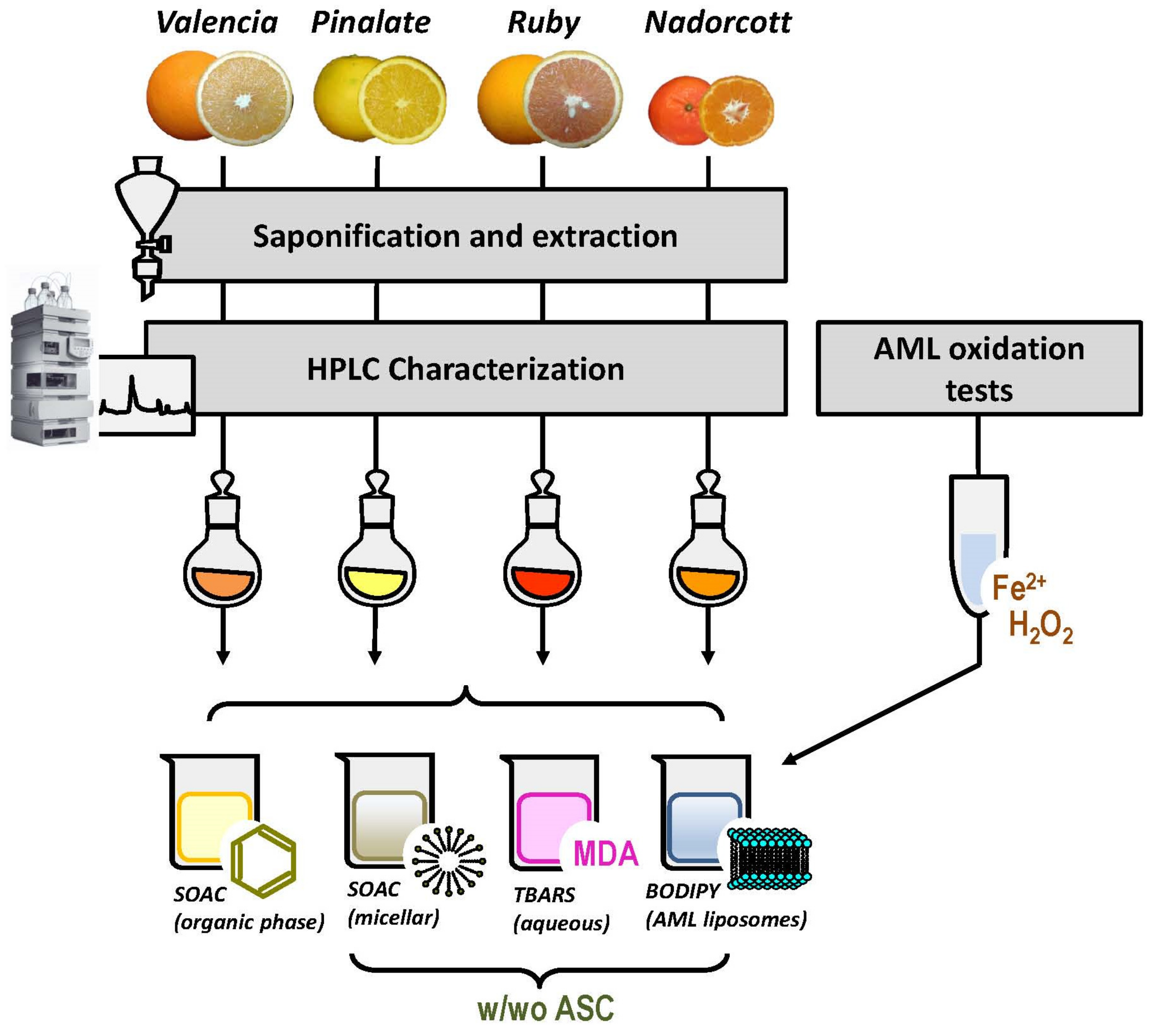
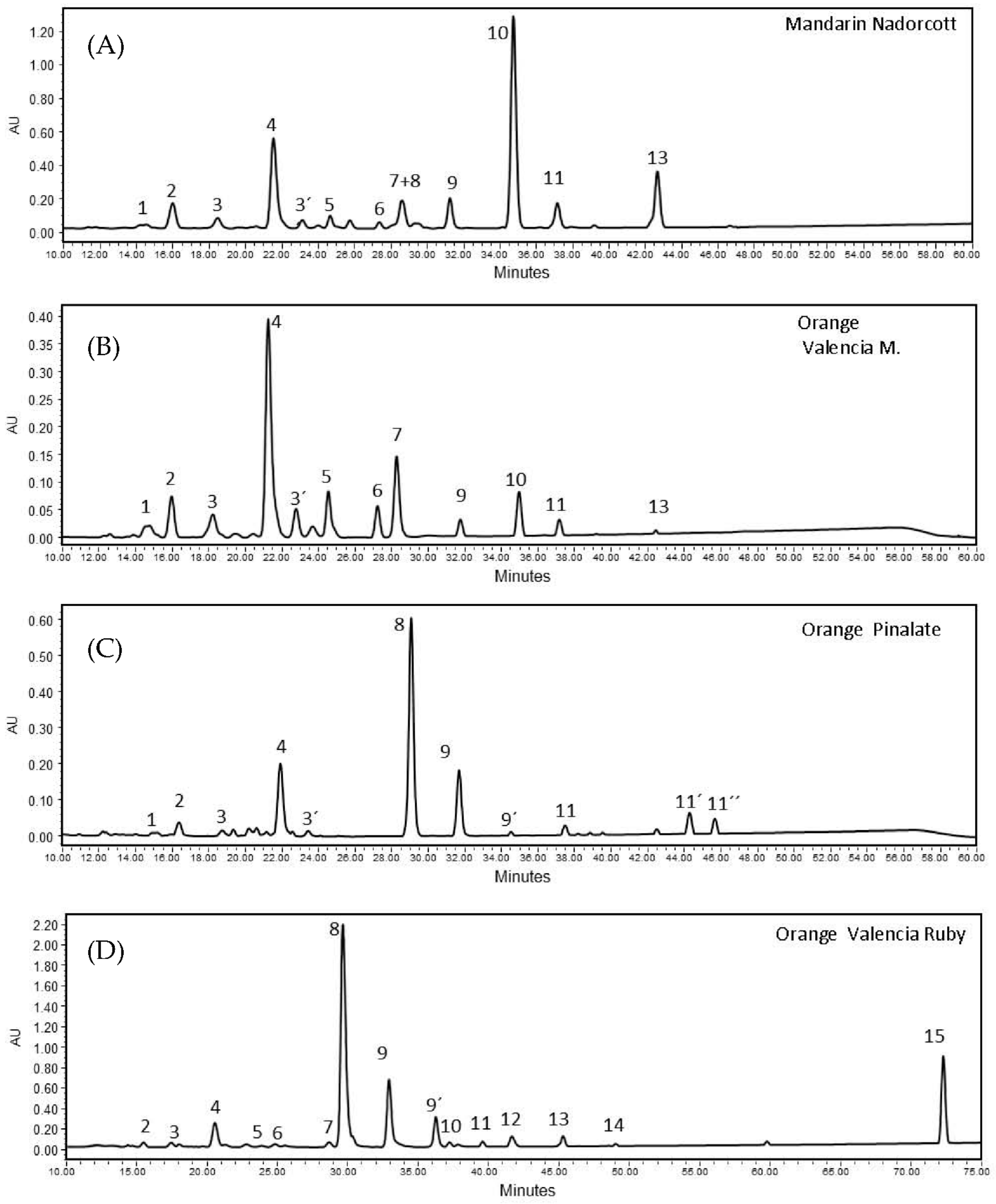

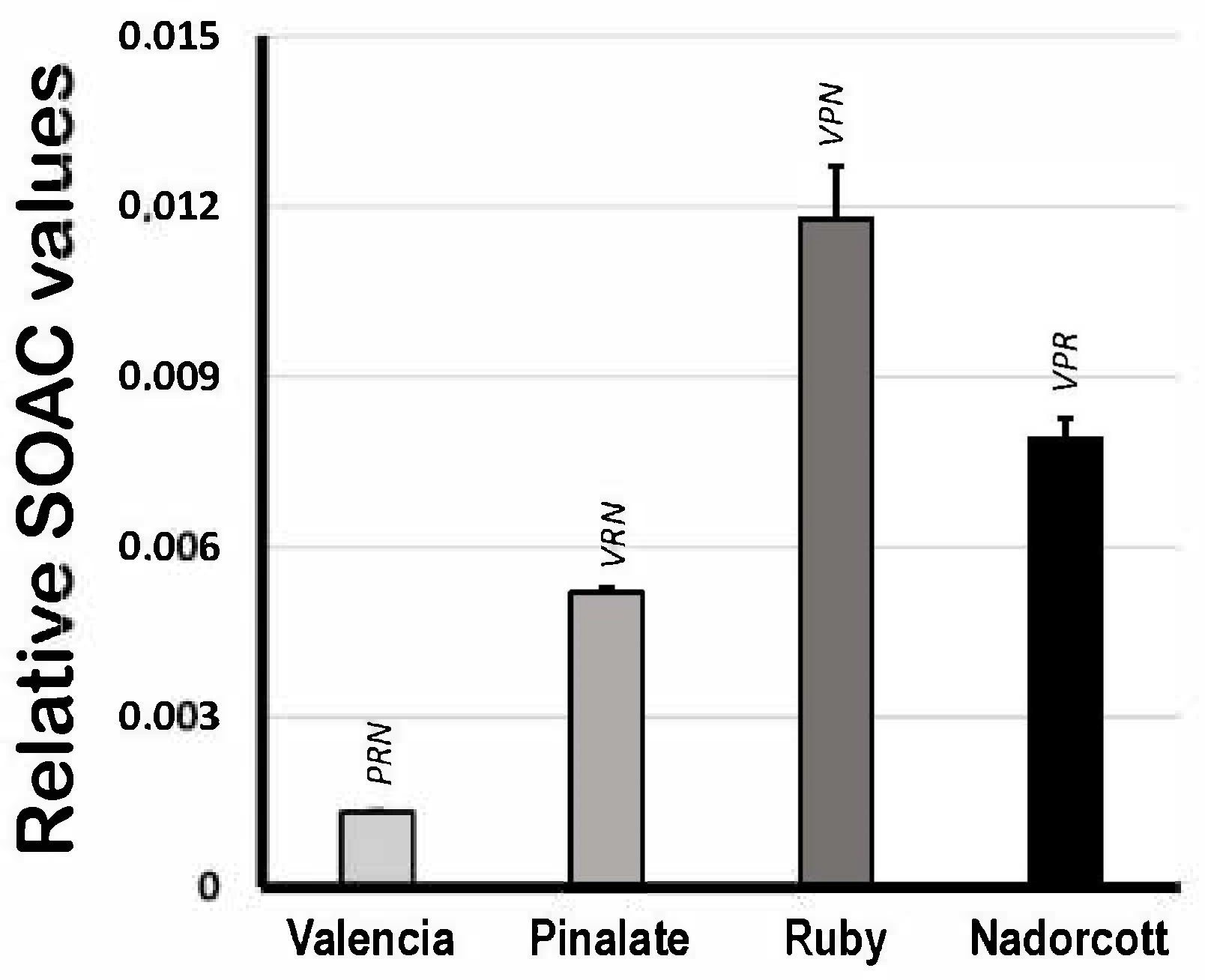
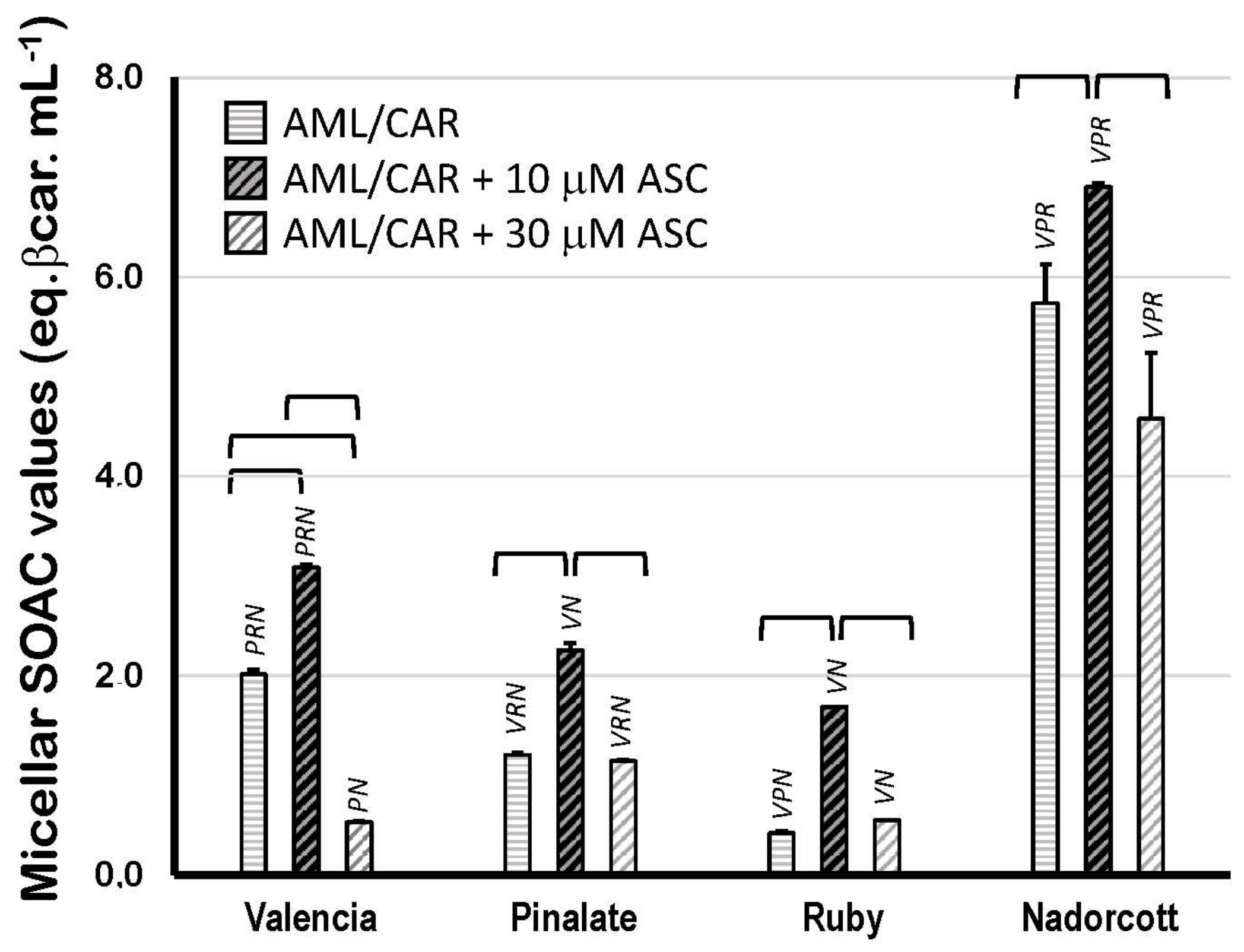
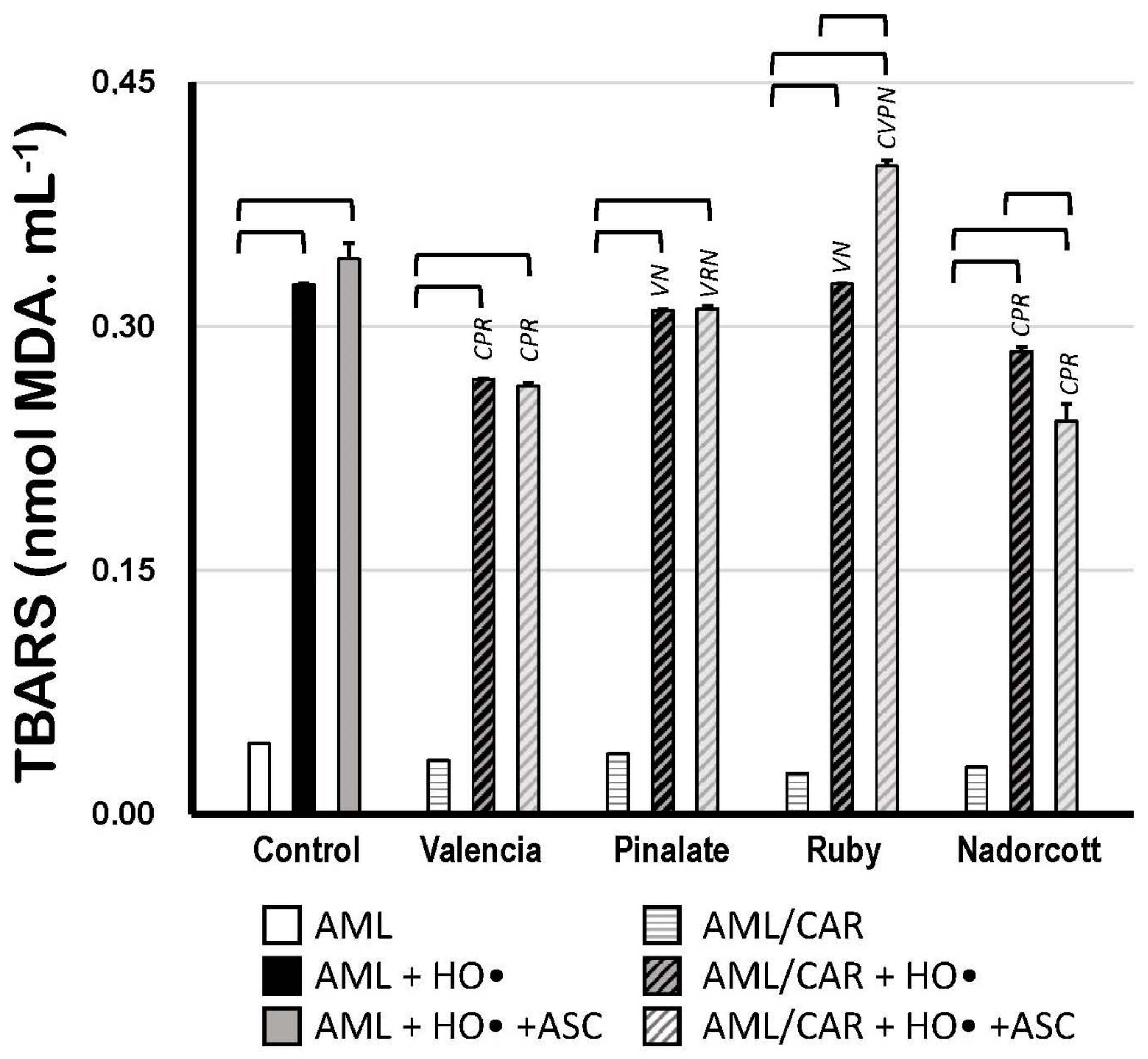
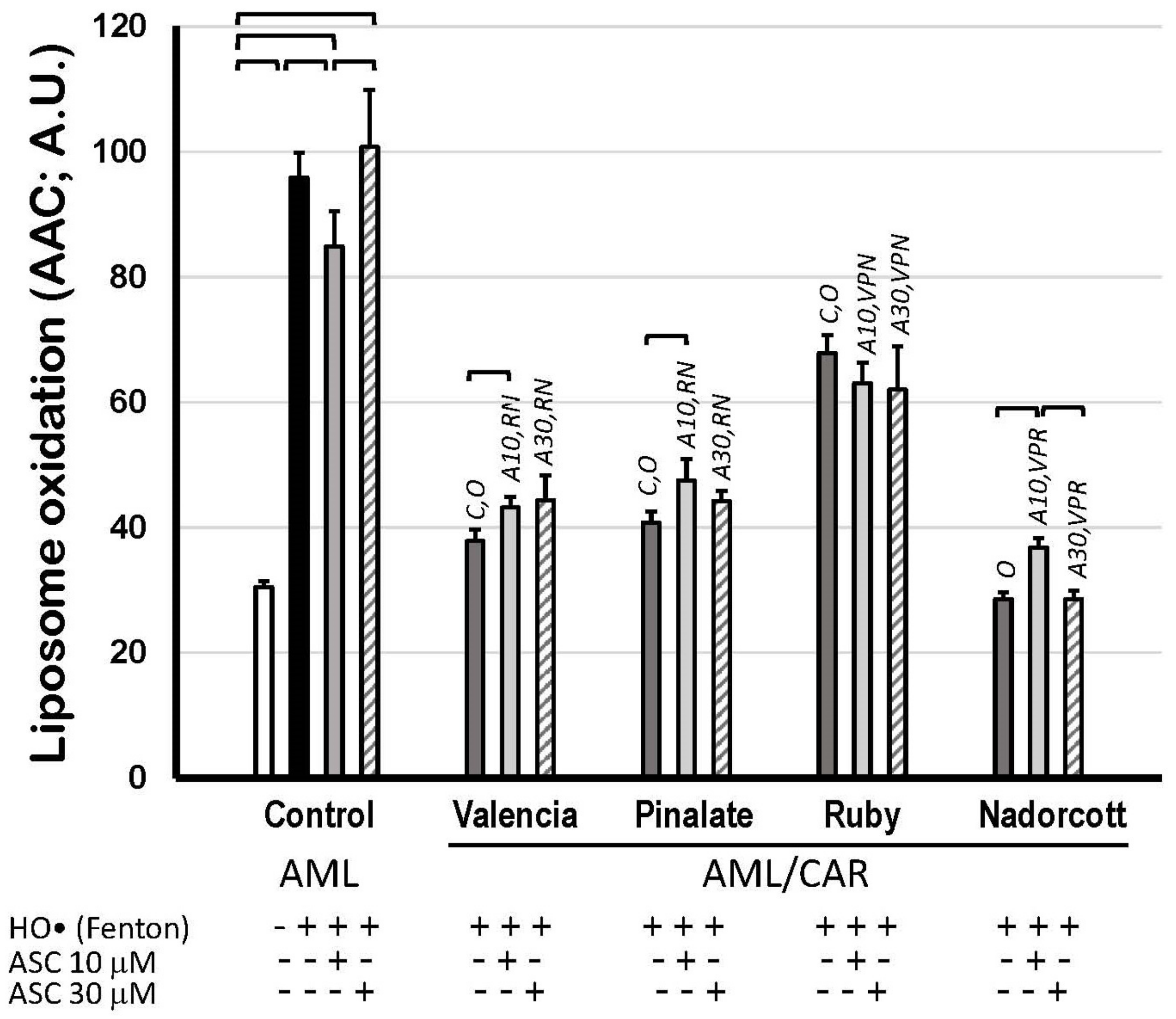
| Carotenoids | ‘Nadorcott’ Mandarin | ‘Valencia’ Orange | ‘Pinalate’ Orange | ‘Ruby’ Orange | ||||
|---|---|---|---|---|---|---|---|---|
| µg/g FW | % | µg/g FW | % | µg/g FW | % | µg/g FW | % | |
| Phytoene | 3.28 ± 0.05 | 10.5 | ND | - | 18.25 ± 1.13 | 74.5 | 83.94 ± 6.54 | 75.2 |
| Phytofluene | 2.42 ± 0.12 | 7.9 | 0.20 ± 0.02 | 3.5 | 2.99 ± 0.77 | 12.2 | 14.58 ± 2.66 | 13.1 |
| ζ-Carotene | 1.46 ± 0.06 | 4.7 | 0.17 ± 0.01 | 3.0 | 1.13 ± 0.18 | 4.6 | 0.43 ± 0.02 | 0.4 |
| Neurospor. | ND | - | ND | - | ND | - | 1.40 ± 0.39 | 1.2 |
| Lycopene | ND | - | ND | - | ND | - | 6.55 ± 0.51 | 5.9 |
| δ-Carotene | ND | - | ND | - | ND | - | 0.35 ± 0.05 | 0.3 |
| Lutein | 0.51 ± 0.05 | 1.6 | 0.41 ± 0.01 | 7.2 | 0.11 ± 0.01 | - | 0.29 ± 0.01 | 0.3 |
| β-Carotene | 2.42 ± 0.39 | 7.8 | traces | - | ND | 0.4 | 0.71 ± 0.01 | 0.6 |
| β-Crypx. | 14.60 ± 0.60 | 46.8 | 0.64 ± 0.02 | 11.4 | ND | - | 0.50 ± 0.03 | 0.4 |
| Zeaxanthin | 0.70 ± 0.09 | 2.2 | 0.40 ± 0.01 | 7.2 | 0.08 ± 0.01 | 0.3 | 0.26 ± 0.01 | 0.2 |
| Anterax. | 0.56 ± 0.21 | 1.8 | 0.79 ± 0.02 | 13.9 | ND | - | 0.36 ± 0.06 | 0.3 |
| All-E-Viol. | 1.07 ± 0.01 | 3.4 | 0.35 ± 0.01 | 6.3 | 0.15 ± 0.01 | 0.6 | 0.24 ± 0.04 | 0.2 |
| 9-Z-Viol. | 3.52 ± 0.15 | 11.3 | 1.94 ± 0.06 | 34.4 | 1.39 ± 0.12 | 5.7 | 1.69 ± 0.13 | 1.5 |
| Luteox. | 0.49 ± 0.01 | 1.6 | 0.53 ± 0.01 | 9.4 | 0.21 ± 0.03 | 0.8 | 0.38 ± 0.11 | 0.3 |
| Neochrome | 0.13 ± 0.01 | 0.4 | 0.19 ± 0.01 | 3.4 | 0.20 ± 0.02 | 0.8 | ND | - |
| TC | 31.21 ± 1.07 | 5.63 ± 0.06 | 24.51 ± 2.26 | 111.69 ± 9.41 | ||||
| Citrus Fruit | BODIPY | TBARS | SOAC | SOACmic | (+ASC) * | TOTAL |
|---|---|---|---|---|---|---|
| ‘Valencia’ | ++ | + | + | ++ | + | (7+) |
| ‘Pinalate’ | ++ | - | ++ | + | + | (6+) |
| ‘Ruby’ | + | - | +++ | + | + | (6+) |
| ‘Nadorcott’ | +++ | + | ++ | +++ | + | (10+) |
Disclaimer/Publisher’s Note: The statements, opinions and data contained in all publications are solely those of the individual author(s) and contributor(s) and not of MDPI and/or the editor(s). MDPI and/or the editor(s) disclaim responsibility for any injury to people or property resulting from any ideas, methods, instructions or products referred to in the content. |
© 2023 by the authors. Licensee MDPI, Basel, Switzerland. This article is an open access article distributed under the terms and conditions of the Creative Commons Attribution (CC BY) license (https://creativecommons.org/licenses/by/4.0/).
Share and Cite
Barros, M.P.; Zacarías-Garcia, J.; Rey, F.; Zacarías, L.; Rodrigo, M.J. Antioxidant Interactions between Citrus Fruit Carotenoids and Ascorbic Acid in New Models of Animal Cell Membranes. Antioxidants 2023, 12, 1733. https://doi.org/10.3390/antiox12091733
Barros MP, Zacarías-Garcia J, Rey F, Zacarías L, Rodrigo MJ. Antioxidant Interactions between Citrus Fruit Carotenoids and Ascorbic Acid in New Models of Animal Cell Membranes. Antioxidants. 2023; 12(9):1733. https://doi.org/10.3390/antiox12091733
Chicago/Turabian StyleBarros, Marcelo P., Jaime Zacarías-Garcia, Florencia Rey, Lorenzo Zacarías, and María J. Rodrigo. 2023. "Antioxidant Interactions between Citrus Fruit Carotenoids and Ascorbic Acid in New Models of Animal Cell Membranes" Antioxidants 12, no. 9: 1733. https://doi.org/10.3390/antiox12091733
APA StyleBarros, M. P., Zacarías-Garcia, J., Rey, F., Zacarías, L., & Rodrigo, M. J. (2023). Antioxidant Interactions between Citrus Fruit Carotenoids and Ascorbic Acid in New Models of Animal Cell Membranes. Antioxidants, 12(9), 1733. https://doi.org/10.3390/antiox12091733








